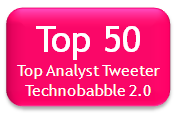 There was an interesting conversation on Twitter yesterday about the personalization of information via algorithm-based filters. It was started by Megan Murray, and Thomas Vander Wal, Gordon Ross, and Susan Scrupski quickly joined in with their viewpoints. Rachel Happe and I were late to the conversation, but we were able to interact with some of the original participants.
There was an interesting conversation on Twitter yesterday about the personalization of information via algorithm-based filters. It was started by Megan Murray, and Thomas Vander Wal, Gordon Ross, and Susan Scrupski quickly joined in with their viewpoints. Rachel Happe and I were late to the conversation, but we were able to interact with some of the original participants.
.The gist of the conversation was that some consumer social services (i.e. Facebook, Google Search, Yahoo News) have gotten rather aggressive about applying algorithms to narrow what we see in our personal activity streams. As a result, we aren’t able to see other information that might be useful or entertaining in our default view; we may only digest what the algorithm “thinks” is important or relevant to us. Or we must switch to a different view to see additional information (e.g. Live Feed v. News Feed in Facebook). Even worse, in some cases, the other information is simply not available to us, because the service doesn’t provide a way to override the algorithm that excluded it.
It was also noted in the Twitter conversation that the current crop of enterprise social software lacks sophisticated personalization facilities. In fact, it works the opposite way of consumer social services; the entire activity stream is usually exposed to an individual, who then has to narrow it by manually selecting and applying pre-defined filters. IBM, Jive, NewsGator, and others are beginning to use algorithms to include certain status events and updates in the stream, and to exclude others, but their efforts will require fine tuning after organizations have experimented with these nascent (or yet-to-be released) personalization features.
The default view of an enterprise activity stream should be highly personalized to the context in which an individual is working (e.g. role, business process, location, time, etc.) Optional views should allow individuals to override the algorithmically chosen results and see information relevant to a specific parameter (e.g. person, group, application, task, tag, etc.) Finally, an individual should be able to view the entire stream, if he or she so desires.
Why is the latter important? It introduces serendipity into the mix. Highly personalized information views can increase productivity for an individual as they do their job, but at the expense of awareness of what else is occurring around them (I wrote about this earlier this week, in this post.) This condition of overly-personalized information presentation has been called a “filter bubble”. The bubble is a virtual, protective barrier against information overload that is analogous to a plastic enclosure used in hospitals to shield highly vulnerable patients from potential infections.
Organizations must consciously balance the need to protect (and maximize the productivity of) their constituents from information overload with the desire to encourage and increase innovation (through serendipitous connection of individuals, their knowledge and ideas, and information they produce and consume.) That balance point is different for every organization and every individual who works in or with it.
Enterprise social software must be designed to accommodate the varying needs of organizations with respect to the productivity versus awareness issue. Personalization algorithms should be easily tunable, so an organization can configure an appropriate level of personalization (for example, InMagic’s core Presto technology features a “Social Volume Knob” that allows an an administrator to control what and how content is affected by social media. Different kinds of social content from certain people can carry different weight or influence.) More discrete, granular filters should be built into social software so individuals can customize their activity stream view on the fly (I made that case, just over a year ago, in this post.) A contextually personalized view should be the default, but enterprise social software must be designed so individuals can quickly and easily switch to a different (highly specific or broader) view of organizational activity.
What do you think? Should personalization be the default, or applied only when desired? What specific filters would you like to see in enterprise social software that aren’t currently available? What role does/could portal technology play in the personalization of organizational information and activity flows? What other concerns do you have about information overload, filter bubbles, and missed opportunities for serendipity and innovation? Please weigh in with a comment below.
This entry was cross-posted from Meanders: The Dow Brook Blog
Image © 2003 Texas Children’s Hospital





